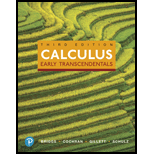
48.
Want to see the full answer?
Check out a sample textbook solution
Chapter 8 Solutions
Calculus: Early Transcendentals (3rd Edition)
Additional Math Textbook Solutions
Intro Stats, Books a la Carte Edition (5th Edition)
Elementary Statistics (13th Edition)
Pre-Algebra Student Edition
Elementary Statistics
Basic Business Statistics, Student Value Edition
University Calculus: Early Transcendentals (4th Edition)
- Which of the functions shown below is differentiable at z = 2? Select the correct answer below: о -7-6-5-4-3-2- −7 −6 −5 −4 −3-2 1 2 4 5 6 -7-6-5-4-3-2- -7-6-5-4-3 2 45arrow_forwardQuestion Given the graph of f(z) below, find the graph of the derivative of f(z). Select the correct answer below: ° ° 129 -7-6-5-4-3-2 -7-6-5-4-3-2-1123456 ° ° °arrow_forwardthe correct answer is A could you explain whyarrow_forward
- Find the given derivative. Dx 7x 1 6 2 이에arrow_forwardQuestion Consider the graph of f(x) below. Over what open interval is f'(x) positive? Give your answer in interval notation. Provide your answer below: 0arrow_forwardQuestion Find the open interval(s) of f(x), graph given below, where f'(x) is negative. -3-2-1 1 2 4 5 6 Give your answer in interval notation. For example, (2, 4) U (6,∞). Provide your answer below:arrow_forward
 Functions and Change: A Modeling Approach to Coll...AlgebraISBN:9781337111348Author:Bruce Crauder, Benny Evans, Alan NoellPublisher:Cengage Learning
Functions and Change: A Modeling Approach to Coll...AlgebraISBN:9781337111348Author:Bruce Crauder, Benny Evans, Alan NoellPublisher:Cengage Learning
